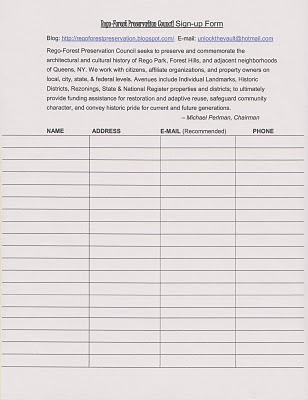Homes Yield to shops on 63rd Drive in Rego Park
By Historian Ron Marzlock, Queens Chronicle & Rego-Forest Preservation Council Blog contributor
From June 3, 2010 "I Have Often Walked" columnBy Historian Ron Marzlock, Queens Chronicle & Rego-Forest Preservation Council Blog contributor
Art Deco shops which took the place of private homes on 63rd Drive between Booth and Saunders streets, in the spring of 1949.
In Rego Park, 63rd Drive was the shopping district that was never meant to be, but was in the end. It and 66th Avenue, formerly White Pot Road, are the two oldest roads in Rego Park, dating to Revolutionary War days. What’s now 63rd Drive, had been known as Remsen Lane, named for the family of Col. Jeromus Remsen, who won fame during the Revolution at the Battle of Long Island, also known as the Battle of Brooklyn. The patriots lost that 1776 melee, leaving the British in control of New York City for the rest of the conflict. The descendants of the Remsen family still owned property on 63rd Drive as late as 1900.
There were 10 different Remsen streets, roads and avenues scattered throughout Queens until 1913, when the borough largely changed over to numbered streets. Remsen Place in Maspeth still exists.
When Rego Park was originally developed in 1925, 63rd Drive was planned to be a quiet residential street. A row of 10 homes was built on its west side between Booth and Saunders streets. The shopping district was on Eliot Avenue and Queens Boulevard. But it was announced as early as 1942 that the Queens Midtown Highway, later named the Long Island Expressway, would be coming directly through the spot where the stores were. Their destruction began in 1954.
Anticipating the need for a replacement strip, Robert E. Hill, Inc. of the Bronx wisely bought the homes on 63rd Drive in 1947 to build stores in their place. One house that escaped, just visible on the left of this photo, was demolished later. The strip has been a major shopping mecca for Rego Park residents ever since.












